To determine if NO2 is polar or nonpolar, we need to first determine its geometry. This presumes knowing the rules for drawing a correct Lewis structure and you can find more details about Lewis structures here.
Nitrogen is the central atom, so we can draw the skeletal structure:

There are 2×6 + 5 = 17 electrons, and 4 of them are used to make 2 bonds. The two oxygens take 6 lone pairs, and the remaining one electron goes to the nitrogen:

As it is drawn, the problems with this structure are that the nitrogen lacks an octet and the oxygens have only one bond and three lone pairs. Remember, the normal valency of oxygens is having two bonds and two lone pairs otherwise a formal charge needs to be assigned.
Therefore, one lone pair from each oxygen is used to make an additional bond with the nitrogen:

Notice that the left oxygen has three lone pairs and one single bond which means there is a negative formal charge on it.
FC= V – (N + B)
Where:
V – number of valence electrons
N – number of nonbonding electrons
B – number of bonds
So, the formal charge of the oxygen will be
FC (O) = 6 – (6 + 1) = -1
For the nitrogen, the formal charge is
FC (N) = 5 – (1 + 3) = +1
So, overall, the molecule is neutral, however, two atoms have formal charges that balance each other.
For geometry, we need to consider the repulsive effect of the electron on the nitrogen. Like a lone pair, it pushes the oxygens down thus making the electron geometry trigonal planar while the molecular geometry is bent.

Now, the polarity: The first thing here is to determine if the N-O bond is polar. Depending on the difference in the electronegativity values, covalent bonds can be polar and nonpolar.

- If the difference in electronegativity is less than 0.5, the electrons are about equally shared between the two atoms, forming a nonpolar a covalent bond.
- If the difference in electronegativity is between 0.5 and 1.7, we have a polar covalent bond.
- A difference of 1.7 or higher is so large that the electrons are no longer shared, and an ionic bond is formed. Ionic bonds are formed between metals and nonmetals.
The N-O bonds are polar and because they are not in opposite directions, the molecule has an overall dipole moment making it polar.

Notice also that instead of showing one single and one double bond with the oxygens, a partial double bond is shown to both which indicates the formal charge is equally shared between the oxygen atoms. This is the resonance hybrid of the molecule.

